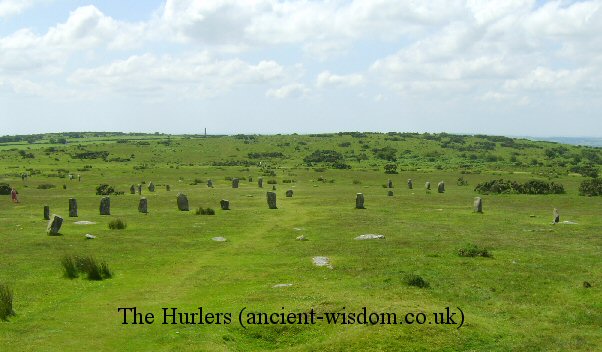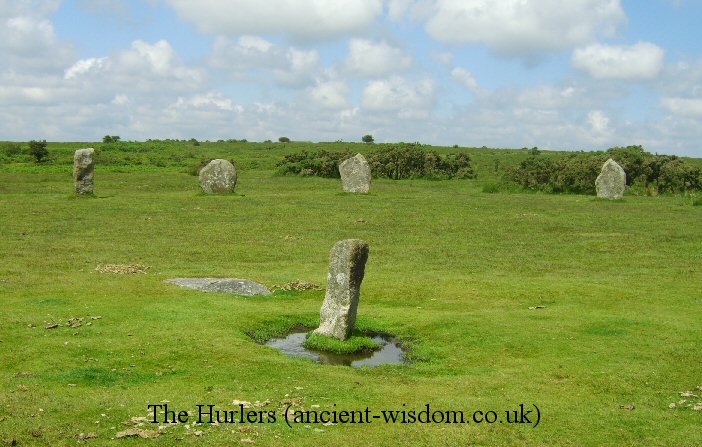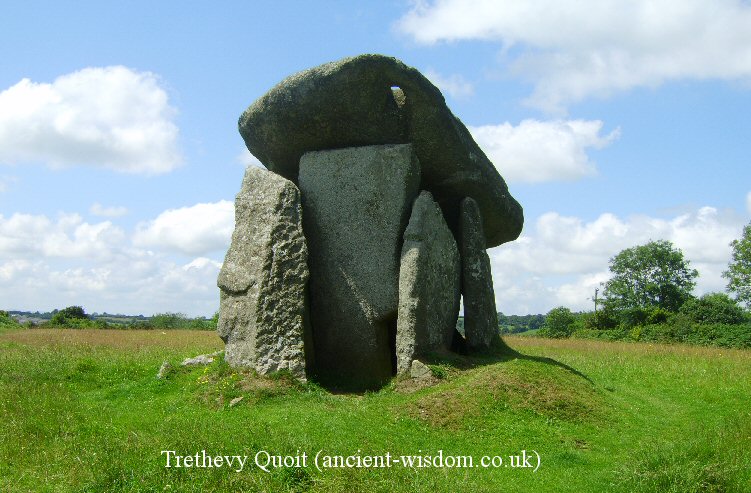|
Location:
Near the village of Minions, Cornwall, England. |
Grid Reference:
50�
31' N, 04� 27.5 W |
 The Hurlers:
(Triple Stone Circle).
The Hurlers:
(Triple Stone Circle).
These three stone
circles, once linked by a gravel pathway are
aligned NNE to SSW, suggestive of an orientation to Orion's belt at
the time they were built in around 1,500 BC.
Situated and aligned
to the St. Michael's Leyline.
(1877
Ground-plan of the Hurlers)
This site consists of
three large
aligned stone circles, running from NNE to SSW, built in a pass, between the
River Fowey and the River Lynher, the sides of Stowe's Hill and Caradon
rising to north and south. Multiple or associated circles are not unusual in
the south-west of England and they often lie between rivers at suitable
positions for converging people and traders. A recent dig has revealed the
presence of a 'Crystal' (Quartz) avenue running between the circles. (

Physical Description of the Circles:
The Southern Circle is the smallest (32.9m/108ft across) and it has only
nine stones left; the largest is The Central circle, slightly egg
shaped, with a diameter of 41.8 x 40.5m (137 x 132ft) and 14
stones, while The Northern circle is 34.7 (113ft) across: 15 stones are here, of
which four have fallen, and there were probably a further nine. The central
and the northern rings were once linked by a granite pathway along their
axis.

Looking
downhill across the three circles.
All the stones in the circles have been carefully erected so
that they all appear the same height. Some stones are diamond-shaped, others round,
and one has been shaped so that its uppermost edge is cloven. A spread of
quartz crystals in the central circle may have come from shaping the stones
with hammers. The northern circle was crossed by a boundary bank, and two
stones 120m (393ft) to the WSW from the central site could be boundary
posts, although astronomical purposes have been assigned them.

The central pillar in the central circle.
Only the
central circle has a large proportion of its stones in-situ, but
this is because they were reset after the site was excavated by
Raleigh-Radford in 1935-6. Fourteen stone uprights survive in
the central circle, with fourteen markers for missing stones,
placed in empty stone sockets during restoration works.
Originally all the circles are said to have contained twenty
nine stones (though the central circle is considerably larger
than the other two) and it was Carew who noted the �...strange
observation that a re-doubled numbering never eveneth with the
first�. The inner faces of the stones are smooth and regular
and most of the stones are flat topped and graded so that the
tallest stones are to the south. This is also the case with the
north circle and possibly also the south circle.

'Male' and
'Female' stones alternate as at Avebury
and other megalithic sites.
It has been
noted that flat lozenge shaped stones tend to alternate with
more slender uprights and it has been proposed that the former
represent the feminine principle whilst the latter represent the
masculine. Excavations revealed a quartz crystal �floor� within
the central circle and the small granite block currently sited
within the circle may originally have marked the true centre.
Although not
set out in a straight line, the centres of the circles trend
towards the ridge to the north, with the still impressive bulk
of Rillaton Barrow on the near horizon and the summit of Stowe�s
Hill with it�s Neolithic tor enclosure and the striking natural
granite formation known as the Cheesewring on the
skyline. These three circles were probably only a single
component of what is commonly termed as a 'ceremonial
landscape'.
Tradition and Myth:
The name The Hurlers refers to an old tradition that
the circles are men or women turned to stone, such as
The Pipers,
The Merry Maidens,
Stanton Drew,
The King Stone
and
The Rollright Stones.
As the historian William Camden wrote in 1610: 'The neighbouring
inhabitants terme them Hurlers, as being by devout and godly error persuaded
that they had been men sometime transformed into stones, for profaning the
Lord's Day with hurling the ball'.
According to another legend, it is
impossible to count the number of Hurlers at Minions, but should you do
so correctly, a misfortune will befall you.
Alignments:
The three circles are aligned NNE to SSW. There are several other examples
of 'triple circles' in Britain, a design feature which can be seen to date
back to the earliest stages of circle building, at the
Thornborough henges
in Yorkshire which date back to around 3,000 BC. The feature of building
three structures, slightly aligned off-centre, and orientated NNE to SSW can
be seen at other ancient structures around the world such as the pyramids of
Ghiza, and Teotihuacan for example.
(More
about Triple Stone-circles)

Two standing
stones known as the Pipers lie to the south-west of the Hurlers
flanking a modern boundary bank. �Outliers� such as these are a
common feature of stone circles in Cornwall and further afield and
they are likely to be prehistoric in origin, re-used as a prominent
landmark when the boundary was first established. Interestingly,
both the Pipers and the Hurlers fall on an approximate alignment
between the �embanked avenue� and stone circle on Craddock Moor and
the prominent barrow group on Caradon Hill. The Pipers may thus
represent a �portal� giving access to the Hurlers from the west.
Astronomy at the Hurlers:
Article: MailOnline.
19 December 2007.
'Hurlers may have been built to
mirror the stars, say astronomers'.
Anthony Harding, Professor of
Archaeology at Exeter University said it was possible that the
Hurlers could have been erected to align with Orion's belt.
"There has been a big debate
about this sort of theory," he said. "Though many archaeologists
are sceptical whether this can be the case. "On December 21 we
will be standing in the line of the three circles we will see
Orion's belt due south in line with the stones."
The three stone circles in
Cornwall have been discovered to align perfectly with the
constellation Orion.
New research now suggests The
Hurlers were built as a primitive calendar which indicates the
exact date of mid winter. Once a year at midnight on the winter
solstice, they line up exactly with Orion's position in the
night sky.
Brian Sheen, a retired
research chemist and astronomer who runs the Roseland
Observatory, in St Stephen, Cornwall, said the stones were built
around 1500 BC. Using a specialist computer programme that
predicts the future position of stars he confirmed the alignment
between Orion and the circles would occur. Mr Sheen said: "As
far as I can tell these Hurlers, a series of three stone
circles, actually mirror the belt of Orion
The
5,500-year-old Earthworks, at
Thornborough, Yorkshire, the Stone Circles on the
Orkney Islands and the
Egyptian Pyramids at Giza are (some
of*) the other known ancient structures linked to Orion.
Anthony Harding, Professor of Archaeology at Exeter University
said it was possible that the Hurlers could have been erected to
align with Orion's belt.
There has been
a big debate about this sort of theory," he said. "Though many
archaeologists are sceptical whether this can be the case".
(1)
* (My Note.)
(Triple-Circles and Orion
Worship)
Other Monuments in the Area.
The Hurlers can
be considered as a single part of a connected landscape. The circles
were positioned so that it is possible to see along three valleys
directly from the site, and there are several other important
monuments nearby including the
Rillaton round barrow, The
Christianised 'Long-stone' menhir, The 'Cheesewring', and
Trethevy Quoit.

Trethevy quoit, locally
known as The Giant's House, is one of England's most impressive
dolmens. The capstone is 3.7m (12ft) long and, in its half-fallen state,
4.6m (15ft) high. There's also a natural hole piercing its highest point.
The function of this port-hole is still a mystery: experts speculate that it
was used for astronomical observations.
The rectangular chamber
is made of six uprights (originally seven), averaging about 3m (10 ft). A
small doorway appears to have been cut out of the entrance stone. The
sloping angle of the stones is reminiscent of many free-standing stones, as
the
Stones of Stenness,
in the Orkney Isles (Scotland). Trethevy is
surrounded by the remains of a mound, which probably once covered the lower
part of the stones.
(More about Holed Stones)
(Dolmens Homepage)
(Archaeoastronomy)
(Stone
Circles Homepage)
(Other
Prehistoric English Sites)
|






